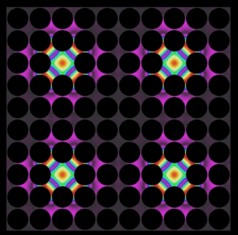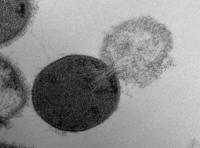Science
How to treat heat like light: New approach using nanoparticle alloys allows heat to be focused or reflected just like electromagnetic waves

The approach relies on engineered materials consisting of nanostructured semiconductor alloy crystals. Heat is a vibration of matter — technically, a vibration of the atomic lattice of a material — just as sound is. Such vibrations can also be thought of as a stream of phonons — a kind of "virtual particle" that is analogous to the photons that carry light. The new approach is similar to recently developed photonic crystals that can control the passage of light, and phononic crystals that can do the same for sound.
- Read more
- 340 reads
Study quantifies the size of holes antibacterials create in cell walls to kill bacteria: Death on a nanometer scale

Research has shown that alternative antimicrobials such as PlyC can effectively kill bacteria. However, fundamental questions remain about how bacteria respond to the holes that these therapeutics make in their cell wall and what size holes bacteria can withstand before breaking apart. Answering those questions could improve the effectiveness of current antibacterial drugs and initiate the development of new ones.
- Read more
- 365 reads
Wavelength-Dependent Shapeshifting: Plasmon-Mediated Growth Control

Methods which allow predictable and reproducible control over the shape and defect structures of nanoparticles are a sought-after ideal in research on nanoparticle synthesis. Realising this ideal for silver nanoparticles is one step closer with the discovery that the localised surface plasmon resonance feature observed for nanoscale metals - the collective oscillation of their electrons caused by incident light - can be used to predictably direct the growth of silver nanocrystals.
- Read more
- 407 reads
NASA Rules Out Earth Impact in 2036 for Asteroid Apophis

Asteroid Apophis was discovered on June 19, 2004.
- Read more
- 382 reads
NASA's GALEX Reveals the Largest-Known Spiral Galaxy
The spectacular barred spiral galaxy NGC 6872 has ranked among the biggest stellar systems for decades. Now a team of astronomers from the United States, Chile and Brazil has crowned it the largest known spiral, based on archival data from NASA's Galaxy Evolution Explorer (GALEX) mission, which has since been loaned to the California Institute of Technology in Pasadena.
- Read more
- 363 reads
Life possible on extrasolar moons

Artist’s conception of two extrasolar moons orbiting a giant gaseous planet.
- Read more
- 361 reads
Herschel intercepts asteroid Apophis

Herschel’s three-colour view of asteroid Apophis
- Read more
- 357 reads
News from the world of quantum physics: A non-causal quantum eraser

This is a long time exposure photography viewing from Tenerife to La Palma. A green laser beam indicates the free-space link between the two laboratories.
- Read more
- 403 reads
Particles of crystalline quartz wear away teeth: Study questions informative value of dental microwear for dietary habits of extinct species

Surface of a tooth, with two large scratches (dark blue lines) that have been caused by quartz particles.
- Read more
- 367 reads
Human Rights
Fostering a More Humane World: The 28th Eurasian Economic Summi

Conscience, Hope, and Action: Keys to Global Peace and Sustainability

Ringing FOWPAL’s Peace Bell for the World:Nobel Peace Prize Laureates’ Visions and Actions

Protecting the World’s Cultural Diversity for a Sustainable Future

Puppet Show I International Friendship Day 2020


